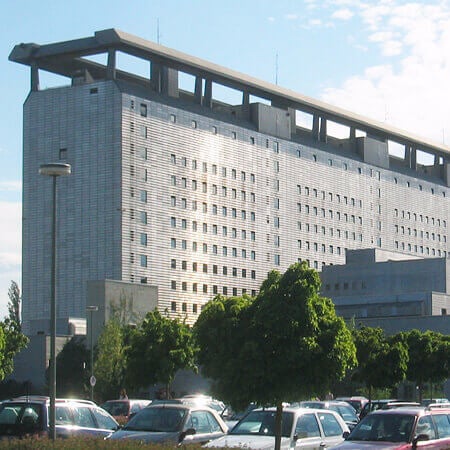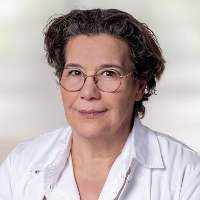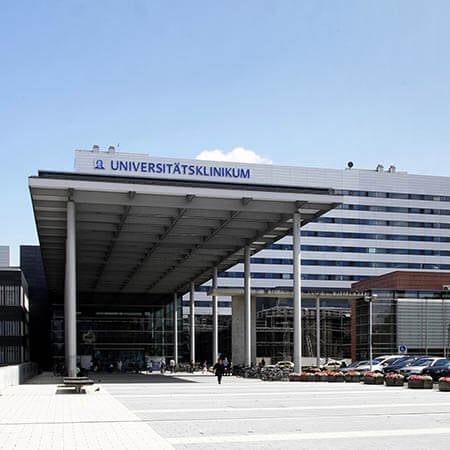Skin Cancer — Laser Surgery: treatment in the Best Hospitals in the World
Treatment prices are regulated by national law of the corresponding countries, but can also include additional hospital coefficients. In order to receive the individual cost calculation, please send us the request and medical records.

Department of Adult and Pediatric Dermatology, Allergology and Phlebology
The Department of Adult and Pediatric Dermatology, Allergology and Phlebology offers all the options of modern medicine for diagnosing and treating skin diseases, allergies, and venereal pathologies. The focus of the department's dermatologists is on patients with various types of skin cancer, psoriasis, eczema, neurodermatitis, acne, venous diseases, and chronic non-healing leg ulcers. The medical facility also admits young patients, including those with rare and genetic skin diseases. The department has an excellent technical base, thanks to which modern laser treatment, light therapy, phototherapy, and advanced sparing surgical interventions are successfully performed here. Top-class medical care is provided by a highly professional team of 60 specialized doctors and 130 nurses, as well as medical and technical workers. About 90,000 patients undergo outpatient treatment, and more than 5,800 patients receive medical care on an inpatient basis annually. The hospital has 160 beds to accommodate patients. The department is thus one of the largest medical facilities of this kind in Germany.






Department of Dermatology and Allergology
The Department of Dermatology and Allergology provides all diagnostic tests and therapeutic measures for the treatment of skin diseases and allergic reactions. The priority area of the department's work is the treatment of malignant skin neoplasms (certification as a Skin Cancer Center of the German Cancer Society). Each patient receives an individual treatment regimen for skin pathology or allergies, which includes the most effective and sparing therapeutic methods.




Department of Dermatology, Venereology and Allergology
The Department of Dermatology, Venereology and Allergology offers the diagnostics and treatment of all dermatological diseases. The department specializes in the very latest methods of surgical dermatology, diagnostics and treatment of skin cancer, venous diseases, as well as all diagnostic and therapeutic methods of modern dermatology, including laser dermatological therapy, phototherapy, photodynamic therapy, etc. The treatment of patients with skin cancer is carried out in close cooperation with colleagues from the University Cancer Center Frankfurt.






Skin cancer is one of the most common tumors in the world. It includes all malignant neoplasms of the skin, with the exception of melanoma, which is considered a separate tumor due to a higher grade. Among non-melanoma neoplasms, basal-cell carcinoma is the most common one – up to 75% of all cases. Squamous cell carcinoma is less commonly diagnosed. Both types of neoplasms can be easily detected at the initial stage, because tumors are visible. In the case of timely treatment of the patient, skin cancer can be removed by laser.
Early detection
Only small neoplasms with a diameter of not more than 2 cm can be removed using laser. To make this method possible, the patient should consult a doctor as soon as possible – ideally, immediately after the detection of symptoms.
The signs of a growing tumor are usually easily detected, since it is located on the skin, and not inside the body. The problems may arise only in localization of skin cancer on the back, scalp or other parts of the body, which are not accessible for examination. However, the tumors in these areas are usually detected, as over time they become large, begin to itch, cause pain or bleed.
To early detect skin cancer, one should regularly carry out self-examinations. Ideally, it should be done once a month. If any suspicious, increasing in size formations appear on the skin, you should consult a doctor and undergo a diagnostics. Not every tumor on the skin is malignant, but in the case of cancer detection, the treatment should be completed as soon as possible in order to reduce the risk of relapse to a minimum and prevent the metastatic spread of the tumor.
Laser principle
The laser has been widely applied in various medical fields during recent years. It is also used in oncology for the removal of small tumors. In oncology, the doctors have two methods of laser exposure to malignant tumors. These include:
- Destruction of tumors using high energy radiation.
- Photochemical effect on tissues.
Laser destruction of skin cancer is carried out in the neoplasm size of not more than 2 cm. The method can be used in single or multiple tumors. The method has the following advantages:
- Sparing effect on surrounding tissues
- Lack of massive blood loss, since the operation involves coagulation (sealing) of the blood vessels
- The laser destroys all bacteria in the wound, and therefore the infectious complications almost never occur
- Tissue regeneration after removal takes place under a dry necrotic crust, which prevents wound infection
A pulsed or continuous laser can be used for removal. In both cases, the destruction mechanism of squamous cell carcinoma or basal cell carcinoma is based on coagulation necrosis of tissues with clear boundaries.
Application areas and efficiency
The main fields of laser application in the treatment of malignant skin tumors are:
- Small neoplasms up to a maximum diameter of 2 cm
- Inaccessible localization
- Relapses of tumors
It is undesirable to use the laser in patients with a tendency to the formation of keloid scars or when the tumor is located near the eyes.
The laser removal is mostly used for skin cancer of the first, less often – second stage. The relapses rarely occur. According to various authors, the use of a pulsed laser results in the relapse rate of 1.1-3.8%. After the removal of a recurrent neoplasm, skin cancer is little more likely to occur in the same place: 4.8-5.6%. The use of СО2 lasers gives a higher relapse rate: 2.8% for removal of primary tumors, 5.7-6.9% for recurrent neoplasms.
The advantages of the laser are good aesthetic results. Therefore, it is often used to remove the tumors located on the face or neck. A good aesthetic effect is provided due to the following aspects:
- Short duration of a therapeutic effect
- Lack of significant heating of the tissues surrounding the affected area
- Quick healing
- Lack of infectious complications
How is the removal performed?
If the patient timely seeks medical care, immediately after the onset of symptoms, the removal is minimally traumatic for him. However, some types of skin cancer are not aggressive, they grow slowly. Therefore, even if the patient ignores the symptoms for a long time and visits a doctor for treatment only a few years after the appearance of neoplasm on the skin, most tumors can still be removed using laser.
The doctor performs skin anesthesia using local anesthetic. It is injected under the skin. This type of anesthesia is called infiltration. During the injection, a slight burning sensation is possible. However, the treatment procedure itself is completely painless for the patient.
The doctor coagulates the skin, which surrounds the tumor. He affects it with laser. The laser pulses cause instant evaporation of fluid from cells. In this case, the thermal effect on neighboring tissues does not penetrate deeply, so there are no burns on the skin.
To reduce the risk of relapse, the doctor makes a resection margin of 0.5-1 cm. The indentation is determined by the characteristics of the disease and the requirements for an aesthetic result. On the one hand, an increase in the area of effect contributes to the formation of a larger scar on the skin, but on the other hand, it is less likely that skin cancer will return after treatment. When performing procedure on the face, the doctor tries to make a resection margin less extensive. At the second stage of cancer, the resection margin will be more extensive than at the first stage with a neoplasm size of up to 1 cm.
Its destruction begins after the formation of the coagulation shaft around the tumor. In this case, the doctor moves from the periphery to the center. The large skin neoplasms can be dissected using laser within a single procedure, along with the surrounding tissues.
What happens after the removal?
The laser removal results in a scab. It looks like a white film and consists of dead tissues. It is important that the patient does not wet this scab during the first days after surgery and does not remove it mechanically. The scab damage increases the risk of infectious complications and can cause the formation of rough, unaesthetic scars.
The scab rejection occurs on average after 3-4 weeks. After the removal of large tumors, especially in elderly patients, this can occur later. The laser is good because after it the wound heals with the formation of a soft scar. This provides an excellent aesthetic result even without follow-up skin grafting. The scar is covered with epithelium, after a few months it is depigmented and becomes minimally noticeable.
Treatment abroad with the Booking Health company
If you want to undergo skin cancer treatment abroad, please, use the services of the Booking Health company. We provide the following benefits:
- Selection of the best Laser Surgery Center, which specializes in the treatment of skin cancer and achieves the best results in this field of oncology.
- Reduced costs for laser surgery services up to 50% due to the lack of overpricing and additional coefficients for foreign patients.
- Booking the appointment on the most suitable dates for you.
- Preparation of a laser surgery program taking into account previously performed examinations.
- Establishment of communication directly with the attending physician.
- Monitoring of the program at all its stages.
- Control of invoices, return of unspent funds.
- Buying and forwarding medicines.
- Organization of additional diagnostics or therapy.
- Communication with the clinic upon treatment completion.
The Booking Health company will provide top-class service. We will book airline tickets and a hotel for you, arrange a transfer from the airport to the clinic and back, upon treatment completion.

